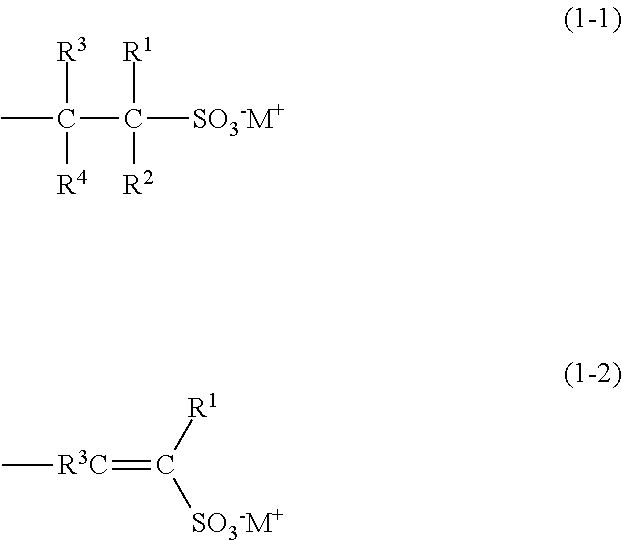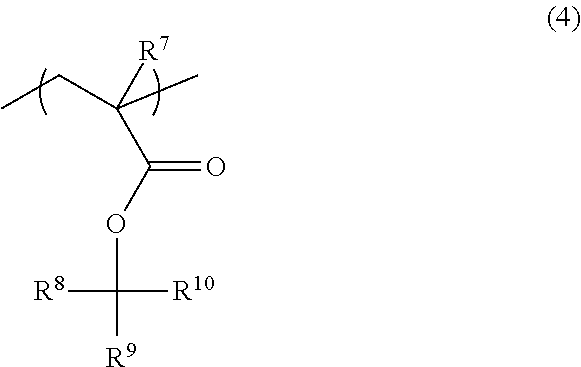Radiation-sensitive resin composition, resist pattern-forming method, acid generator and compound
a technology of resist pattern-forming method and radiation-sensitive resin, which is applied in the direction of photosensitive materials, instruments, photomechanical equipment, etc., can solve the problems that the above-mentioned conventional radiation-sensitive resin compositions are incapable of meeting these demands, and achieve the effect of improving the lwr performance of radiation-sensitive resin compositions and reducing lwr
- Summary
- Abstract
- Description
- Claims
- Application Information
AI Technical Summary
Benefits of technology
Problems solved by technology
Method used
Image
Examples
example 1
Synthesis of Compound (B1-1)
[0326]A compound represented by the following formula (B1-1) was synthesized according to the following scheme.
[0327]Synthesis of Compound (m-2)
[0328]To a 200 mL eggplant shaped flask were charged 5.0 g (26 mmol) of 2-bromo-3,3,3-trifluoropropan-1-ol (the compound (m-1)), 6.5 g (52 mmol) of Na2SO4 and 40 mL of H2O, and the mixture was stirred at 85° C. for 48 hours under a nitrogen atmosphere. After cooling to room temperature, 7.5 g (25 mmol) of triphenylsulfonium chloride and 120 mL of dichloromethane were added to the reaction solution, and the mixture was stirred at room temperature for 3 hours. After completing the reaction, only the organic layer was recovered, and the recovered organic layer was washed three times with 20 mL of water and dried over anhydrous magnesium sulfate. Thereafter, the residue obtained by concentrating the organic layer in vacuo was purified by silica gel column chromatography (developing solvent: dichloromethane / MeOH=10 / 1 (...
example 2
Synthesis of Compound (B1-2)
[0332]A compound represented by the following formula (B1-2) was obtained (2.7 g, yield 45%) in a similar manner to Example 1 except that a compound represented by the following formula (m-3) was used in place of 1-adamantanecarbonyl chloride used in Example 1.
[0333]1H-NMR data of the compound (B1-2) thus obtained are shown below:
[0334]1H-NMR (CDCl3) δ: 1.00 (s, 6H, CH3), 1.25 (s, 3H, CH3), 1.70 (m, 1H, CH), 1.93 (m, 2H, CH), 2.16 (m, 1H, CH), 3.20 (m, 2H, CH2), 6.00 (m, 1H, CH), 7.67-7.83 (m, 15H)
example 3
Synthesis of Compound (B1-3)
[0335]A compound represented by the following formula (B1-3) was synthesized according to the following scheme.
[0336]Into a 500 mL eggplant shaped flask were charged 4.5 g (15.6 mmol) of the compound (m-4), 2.1 g (20.3 mmol) of NaHSO3, 75 mL of MeOH, 25 mL of CH3CN and 75 mL of H2O, and the mixture was stirred at 60° C. for 10 hours under a nitrogen atmosphere. After completing the reaction, the reaction solution was concentrated in vacuo until the volume of the reaction liquid was reduced to approximately ¼ of the initial volume. To this, 3.7 g (12.5 mmol) of triphenylsulfonium chloride and 100 mL of dichloromethane were added, and the mixture was stirred at room temperature for 5 hours. After completing the reaction, only the organic layer was recovered, and the recovered organic layer was washed three times with 30 mL of water and dried over anhydrous magnesium sulfate. Thereafter, the residue obtained by concentrating the organic layer in vacuo was pu...
PUM
| Property | Measurement | Unit |
|---|---|---|
| temperature | aaaaa | aaaaa |
| temperature | aaaaa | aaaaa |
| pore size | aaaaa | aaaaa |
Abstract
Description
Claims
Application Information
 Login to View More
Login to View More - R&D
- Intellectual Property
- Life Sciences
- Materials
- Tech Scout
- Unparalleled Data Quality
- Higher Quality Content
- 60% Fewer Hallucinations
Browse by: Latest US Patents, China's latest patents, Technical Efficacy Thesaurus, Application Domain, Technology Topic, Popular Technical Reports.
© 2025 PatSnap. All rights reserved.Legal|Privacy policy|Modern Slavery Act Transparency Statement|Sitemap|About US| Contact US: help@patsnap.com



